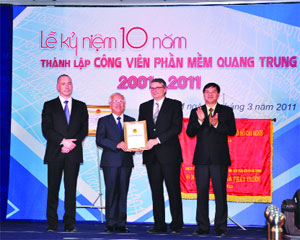 Vietnam has every reason to cherish the hope of creating an international research and development (R&D) community in the country and cultivating a Vietnamese branded software industry.
Vietnam has every reason to cherish the hope of creating an international research and development (R&D) community in the country and cultivating a Vietnamese branded software industry.
With the HP’s $10 million project, the Quang Trung Software Park has officially become a trustworthy address on the R&D service map of the world.
Vietnam has every reason to cherish the hope of creating an international research and development (R&D) community in the country and cultivating a Vietnamese branded software industry.
With the HP’s $10 million project, the Quang Trung Software Park has officially become a trustworthy address on the R&D service map of the world.
HP’s plan
The project on a global research and development (R&D) center belonging to HP group has been granted a license to operate in Quang Trung Software Park, worth 10 million dollars. The center will undertake the research and testing of HP’s software products and global services. In the first two years of operation, HP will need more than 3000 square meters of office space right at the Quang Trung Software Park. After 2012, the Quang Trung Software Development Company (QTSC) will provide to HP 10,000 square meters of office space at the new office building.
“This is a project which is really significant to Vietnam’s software industry,” said Chu Tien Dung, Chair of the Board of Members of QTSC, adding that this is a kind of non-factory operation, mostly based on Vietnamese creative labor force and direct investment from HP. The project is expected to have important impacts on the software industry and information technology services in HCM City.
The HP’s R&D Center plans to increase the number of engineers from 50 to 200 by the end of the year. Every quarter, the center may need 30-50 engineers on average. If everything goes smoothly, the center will have 500 engineers by 2012 and more than 1000 engineers in the next few years.
Francesco Serafini, a senior executive of HP Group, has stressed that HP plans to expand the R&D center in Vietnam, if the Vietnamese labor force can meet the requirements of the group.
A R&D business community taking shape
If considering the investment capital, the HP’s project would be considered a small project if comparing with hardware development projects, capitalized at hundreds of million of dollars. However, experts have pointed out that there is no need to compare two kinds of projects that have different characteristics. Though HP’s project has a low initial investment capital, it can bring big benefits. They said the project will help the Vietnamese labor force, the most important factor in the forming and operation of R&D centers, make its mark in the hi-tech labor force map of the world.
To date, HP has had two R&D centers in India and China, and Vietnam is the first South East Asian country that will have an HP R&D center. With 1000 workers in the first phase of operation and an average productivity of Vietnamese software workers at 15,000-20,000 dollar per annum, the added value the center can bring to Vietnam’s information technology will be 15-20 million dollars per annum.
Experts have also pointed out that the HP’s investment project in Vietnam will help lure other foreign investors, because HP’s satellite enterprises may follow the steps of HP to come to Vietnam. Infornam, Global CyberSoft Vietnam, or IBM Lab have also invested in R&D.
TMA Solutions, which is considered the second largest software processing company also set up a R&D center at QTSC last year. Nguyen Huu Le, Chair of TMA Solutions, said besides the implementation of the service contracts for foreign partners such as Nortel, Alcatel-Lucent, Juniper Network, NEC Corporation, the company is joining forces with domestic technology companies to develop domestic products. As such, a community of R&D brands at QTSC can be seen in a near future.
The dream of Vietnamese software technology
In 2010, Vietnam earned one billion dollars from the software industry, while the figure is expected to increase to two billion dollars in the next few years. However, very few products of Vietnamese enterprises have been registered for protection under intellectual property laws. To date, Vietnamese enterprises have been just been performing outsourcing for foreign enterprises.
According to Henry Nguyen Huu Thai Hoa, Quality Director of Schneider Electric in Asia Pacific, who spent two years working as the advisor to the Minister of Science and Technology, Vietnam will be able to escape from the current situation when the R&D content in Vietnamese software products increases.
Source:
Vietnamnet
 Vietnam
Vietnam

 Previous page
Previous page Back to top
Back to top







